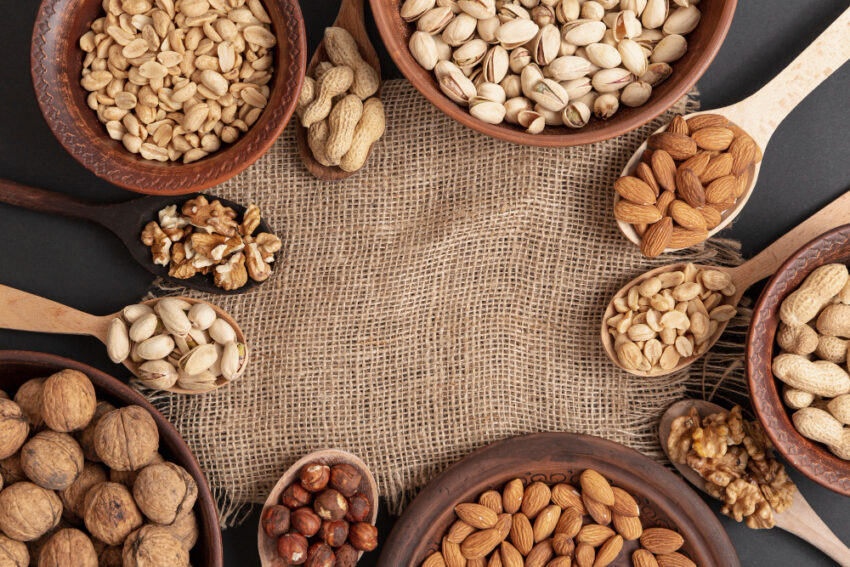Introduction
When it comes to managing your blood sugar levels, understanding the Glycemic Index of dry fruits is a helpful tool to have. This index rates carbohydrates based on how they affect your blood sugar. The scale ranges from 0 to 100, with low-GI foods having a value of 55 or less, moderate-GI foods falling between 56 and 69, and high-GI foods being 70 or higher. The lower the GI, the slower the rise in blood sugar after eating.
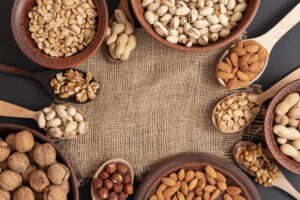
Table of Contents
What is the Glycemic Index (GI)?
The Glycemic Index of dry fruits, or GI for short, is like a report card for carbohydrates. It tells us how quickly a carbohydrate-containing food can raise our blood sugar levels. The scale ranges from 0 to 100, with low-GI foods having a value of 55 or less, moderate-GI foods falling between 56 and 69, and high-GI foods being 70 or higher. The lower the GI, the slower the rise in blood sugar after eating.
Why Dry Fruits?
Dry fruits, such as almonds, raisins, and dates, are popular for snacking and as ingredients in various dishes. They are nutrient powerhouses, loaded with vitamins, minerals, and healthy fats. However, even though they are healthy, their impact on blood sugar can vary due to differences in the Glycemic Index.
Factors Affecting Glycemic Index of Dry Fruits
In Dry Fruits Several factors influence the Glycemic Index of dry fruits. First, it’s the sugar content. Dry fruits have natural sugars, and some have more than others, affecting their Glycemic Index. Second, fiber matters. Fiber can slow down the absorption of sugar, which impacts the Glycemic Index. Lastly, processing methods can alter the Glycemic Index. For instance, drying methods can concentrate sugars.
Low Glycemic Index Dry Fruits
Now, let’s look at some dry fruits with low Glycemic Index values. These are the good guys when it comes to blood sugar management.
1. Cherries: Cherries have a low Glycemic Index, around 22. They are also packed with antioxidants and are a tasty addition to your diet.
2. Prunes: Prunes have a Glycemic Index of about 29. They are famous for promoting digestive health and are a smart choice for a low-GI snack.
3. Grapefruit: Grapefruit has a GI of around 25. This citrus fruit is not only refreshing but also friendly to your blood sugar levels.
4. Walnuts: Walnuts, often considered a nutritional powerhouse, come with a pleasantly low Glycemic Index (GI), typically registering below 15. This means they have a minimal impact on blood sugar levels. Moreover, walnuts are rich in heart-healthy omega-3 fatty acids and provide a good dose of antioxidants and essential minerals.
5. Pistachios: Pistachios, known for their distinctive flavor and vibrant green color, fall into the low-GI category with a GI of around 20. These little green gems not only contribute to stable blood sugar but also offer a satisfying crunch and a wealth of nutrients like protein, fiber, and healthy fats.
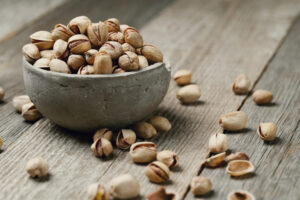
Moderate GI Dry Fruits
Here are some dry fruits with moderate Glycemic Index values. While they aren’t as blood sugar-friendly as the low-GI options, they can still be part of a balanced diet.
1. Apricots: Apricots have a GI of about 57. They provide vitamins A and C and can be a delightful addition to your breakfast.
2. Figs: Figs have a Glycemic Index of around 61. They are a good source of dietary fiber, which can help offset their moderate Glycemic Index.
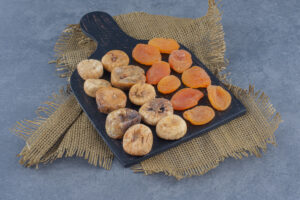
3. Raisins: Raisins have a GI of approximately 64. While higher in sugar, they still offer some nutritional benefits, such as iron and potassium.
4. Cashews: Cashews, while delicious and creamy, have a moderate GI, usually ranging from 22 to 27. Although they aren’t as low on the GI scale as walnuts or pistachios, cashews are still packed with vitamins, minerals, and healthy fats. Just be mindful of portion sizes to manage blood sugar effectively.
5. Pecans: Pecans, with a GI hovering around 15 to 30, belong to the moderate-GI group. These sweet and buttery nuts offer a delightful flavor and contribute healthy fats to your diet. Pecans are also a good source of antioxidants and fiber, which can help offset their moderate GI.
6. Hazelnuts: Hazelnuts, often used in baking and confections, have a moderate GI, typically ranging from 22 to 30. They bring a unique flavor and texture to dishes while providing essential nutrients like vitamin E and healthy fats. Incorporate hazelnuts mindfully into your diet to maintain steady blood sugar levels.
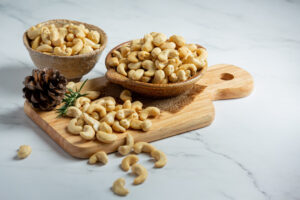
High Glycemic Index Dry Fruits
Now, let’s talk about dry fruits with high Glycemic Index values. These should be enjoyed in moderation, especially if you’re concerned about blood sugar levels.
1. Dates: Dates have a high GI, about 103. They are sweet and energy-packed, but consuming them in excess can lead to rapid blood sugar spikes.
2. Watermelon: Watermelon has a Glycemic Index of around 76. While it’s hydrating and delicious, it’s best to enjoy it in moderation if you’re watching your blood sugar.
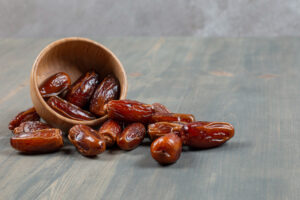
Balancing Dry Fruits in Your Diet
So, how can you incorporate dry fruits into your diet while managing your blood sugar levels and considering the Glycemic Index of dry fruits?
- Portion Control: It’s crucial to keep portions in check. A small handful of dry fruits can be a satisfying snack without causing significant blood sugar spikes, thanks to their lower Glycemic Index.
- Pairing: Combine dry fruits with low-GI foods, such as vegetables, whole grains, or lean proteins. This helps offset the impact on your blood sugar while enjoying the goodness of dry fruits and their Glycemic Index.
- Soaking: Some people find that soaking dry fruits can reduce their Glycemic Index. This method can be especially helpful for high-GI dry fruits like dates.
FAQs
1. What is the Glycemic Index (GI) of dry fruits?
- The Glycemic Index (GI) of dry fruits is a measure of how quickly the carbohydrates in these fruits raise blood sugar levels when consumed. It helps in understanding the impact of different dry fruits on blood glucose levels.
2. Which dry fruits have a low Glycemic Index?
- Dry fruits such as almonds, walnuts, and peanuts typically have a low Glycemic Index. They are a good choice for those looking to manage blood sugar levels.
3. How can the Glycemic Index of dry fruits benefit my health?
- Knowing the GI of dry fruits can help you make informed dietary choices. Low-GI dry fruits can provide sustained energy, help with weight management, and aid in blood sugar control for those with diabetes.
4. Are there any precautions for individuals with diabetes regarding dry fruits?
- Yes, individuals with diabetes should consume dry fruits in moderation due to their calorie and carbohydrate content. It’s advisable to consult with a healthcare provider or nutritionist to determine an appropriate portion size based on individual dietary needs.
Conclusion
In conclusion, dry fruits are a wonderful addition to your diet. They are packed with nutrients and make for convenient, portable snacks. However, it’s essential to be mindful of their Glycemic Index, especially if you’re managing blood sugar levels. Choosing low-GI dry fruits like cherries and prunes, enjoying moderate-GI options in moderation, and being cautious with high-GI dry fruits like dates. With the right choices and portion control, you can savor the goodness of dry fruits while keeping your blood sugar in check, all by understanding the Glycemic Index of dry fruits.

